Look at the following news headlines-
“Amid price hike, Tomato thefts have been reported from different parts of the country.”
“Karnataka police registered a case for smuggled tomatoes worth Rs.1.5 lakh.”
“Vegetable traders are installing CCTV cameras as a precaution to prevent vegetable thefts.”
A common thing that is haunting all the Indians in this monsoon is the astronomical price of veggies. For now, Tomato has taken over the throne for being the most valuable vegetable. Why valuable and not just expensive? You may ask. Can you name any ordinary Indian cuisine where tomato isn’t used? Quite difficult to remember. Right?

Veggies are an integral part of our culture. Sadly, since the last decade, vegetable prices are rising steadily… Reason? Well, there are many factors that led to this whopping price of veggies.
Let’s explore the reasons one by one!
Story so far
Have a brief look at the vegetables’ prices in the National Capital Region–
| Vegetable | Wholesale Price | Retail Price | Unit |
| Tomato | Rs.116 | Rs.133-147 | 1 kg |
| Ginger | Rs.81 | Rs.93-103 | 1 kg |
| Lemon | Rs.50 | Rs.58-64 | 1 kg |
| Green Chilly | Rs.59 | Rs.68-75 | 1 kg |
| Onion | Rs.53 | Rs.61-67 | 1 kg |
| Broad Beans | Rs.43 | Rs.49-55 | 1 kg |
| Carrot | Rs.51 | Rs.59-65 | 1 kg |
| Capsicum | Rs.45 | Rs.52-57 | 1kg |
| Okra (Ladies Finger) | Rs.41 | Rs.47-51 | 1 kg |
Do you know, in some parts of India like Uttarakhand and Mumbai, the price of tomatoes surpassed petrol’s price? It reached Rs.250 and Rs.150 per kilogram respectively.
These prices are sky-high enough to send shockwaves across the country. Eventually, our countrymen are tackling these soaring costs with severe distress! India is known as the land of vegetables. Unlike non-vegetarian dominant countries, we are more dependent on vegetarian sources of food. Also, we are blessed with fertile lands across the Ganga-Yamuna plains!

Then how come we are facing these unprecedented levels of staple vegetable prices? You know, it’s not a new thing anymore. Every year we see the rising costs of these fresh produce. Do you remember how we faced the sharp rise of Lemon in the summer of 2022?
The rising of prices adversely impacts our economy. How can we solve it?
Well, for that you need to dig into the factors that led to these whopping costs of veggies. Then only we can find the solutions.
Key Reasons: Why Vegetable Prices Are Rising?
Here comes the core of this write-up. The following are the reasons for the surging vegetable prices-
1. Irregular Rainfalls & Crop Damage

These two factors are interrelated to rising vegetable prices, therefore, considered as one. None of us are unaware of the fact that monsoons lead to the rotting of crops.
Who’s to blame? The heavy rainfall and the humid climate! Excessive waterlogging and flooding harm crops and reduce their shelf life. Eventually, such veggies become unfit for human consumption.
However, that’s not the only reason.
The scanty rainfall equally damaged the crops too! How? When your crops don’t receive optimum rains during high temperatures, they dry out. The variation in rainfall and temperature led to pest attacks and crop rots.
Let’s look at the reasons for crop damage in different parts of India.
| Region | Reasons for crop damage |
| Karnataka | Insufficient rains, high temperature, and pest attacks i.e. Curl Disease. |
| Maharashtra | Severe heat wave and delayed rains |
| Rajasthan | Cyclonic Storm- “Biparjoy” & Heavy rainfall |
| Himachal Pradesh | Heavy rainfall |
| Uttar Pradesh | Unseasonal rainstorms |
| Haryana | Heavy rainfall |
Most of the vegetable production occurs in these Indian states. Therefore, we are highly dependent on them. When the monsoon exerts a negative impact on these places, we see a shortage of veggies accompanied by surging costs.
By reading all the reasons described above, you can easily relate to the current circumstances of the vegetable market.
For instance, take a case of tomato prices in Bengaluru and Nashik. Usually, in these places, the wholesale price is Rs.60-65 per kg. But due to crop damage, the price rises to Rs.80-85 per kg. And when you add taxes, commission, and wages to it, the final retail price becomes Rs.100-120 per kg.
2. Post-Harvest Losses

The crop damage leads to post-harvest losses. How? When crops are damaged during growth or harvesting, they become more susceptible to pests, diseases, and deterioration. Damaged crops have weak defense mechanisms, making them vulnerable to infestations and rot.
Furthermore, physical damage can accelerate the spoilage process, causing the crops to decay faster. Inadequate storage facilities and improper handling practices can exacerbate the situation, leading to further losses.
Ultimately, crop damage reduces the overall quality and quantity of harvested crops. As a consequence, we see significant post-harvest losses impacting food security and economic sustainability.
3. Disruption of Supply Chains, Transportation, and Logistics

Seamless transportation and logistics are critical to fetch vegetables from the farmers to markets. You must be aware of water-logging situations in various parts of the country. This flooding scenario heavily disrupts the transportation of goods including vegetables.
The issues with storage, packaging, or distribution of vegetables & fruits also contribute to price increases.
Additionally, if there are disruptions in transportation networks or increased fuel costs. It can affect the distribution of vegetables. Higher transportation costs can lead to increased prices for consumers as the expenses are passed on to them.
4. Increased Demand and Change in Consumption Patterns

Shifts in dietary preferences or an increase in the demand for certain vegetables impact prices. If the demand for a particular vegetable increases but the supply remains the same, prices are likely to rise.
The current scenario is a perfect example of it.
The month of July and August is considered holy month (Shraavan) as per Hinduism. So, there has been a huge shift to a vegetarian diet all of a sudden. As a result, the demand for fruits and vegetables increased sharply along with the vegetable shortage.
Thus, it immensely contributed to the rise of vegetable prices!
How vegetable price hike impacts the economy?
The RBI has already expressed concerns about inflation i.e. rising vegetable prices. How did it know that we will face it in the current months? Well, it already predicted the agricultural outcomes due to the impact of El Nino. What’s that? It refers to a weather condition with irregular rainfall that you are already facing in various parts of India. Himachal Pradesh and Delhi NCR are facing floods whereas Bengal is facing droughts. This is a severe impact of climate change.

Note: We have explained “El Nino & its impact on Indian Economy” in detail. You can look at it for more details.
The sudden rise in vegetable prices will intensify the inflationary pressures on India.
Strategies to Tackle Surging Vegetable Prices
On reading this sub-topic, you may think- “Isn’t it the government who is responsible to set the price of veggies? How can common folks solve this problem?”
Well, it’s true to some extent. But we can use some innovative strategies to preserve veggies and increase their shelf life.
1. Opting for alternative protein sources

During the days of vegetable price hike, you can simply reduce veggies consumption and look for alternatives. We all know that the surging veggies price is temporary and will cool down soon. Thus, for the time being, you can explore plant-based protein sources like-
- Beans
- Lentils
- Chickpeas
These are highly nutritious and you can cook in different forms too! Numerous frozen foods, sauces, ketchup, tomato purees, and canned options are available too. However, it is better to have fresh pulses instead of compromising on health through canned foods.
2. Preserving water-filled veggies in brine water

Mysore-based CFTRI (Central Food Technological Research Institute) developed an innovative strategy to preserve wet veggies. With wet vegetables, we refer to those that have more water content. For instance, a potato is a dry vegetable and a tomato is a wet vegetable. Therefore, you can have normal storage for the former. But for the latter, you need to modify the storage system.
Thankfully, CFTRI developed a new method to store tomatoes. What’s that? Brine Water! It is a salt-based solution (liquid) that prevents and inhibits the growth of bacteria. Thus, it increases the shelf life of wet vegetables.
Won’t it be expensive? You may ask. But to your surprise, the cost of storing tomatoes in brine water is hardly Rs.3 per kg.
It is similar to Amul’s milk storage capacity in powder form. (Note: We have covered it in the “Amul Case Study.” Here, you will get detailed info on the Milk Storage Tactics of Amul).
Final Words
Thus, these are the solutions to tackle the rising vegetable prices. What’s the stance of our government in this scenario? As per the govt., the current price hikes are a brief seasonal phenomenon and the price will fall soon. It is a temporary phenomenon that occurs every year. Traders as well as folks desperately hope that the prices will come down soon.
It will take nearly 20-25 days for the new crops to arrive on the market. Till then you can go for alternatives and better storing ways for conserving veggies!


The article talks about every year’s scenario. This year the EL Nino flood impacted some parts of India. Obviously, when there will be new veggies or fruits in the market, sellers will drop the rate in the upcoming 25-30 days. The reason behind it is that they do not want to face the loss of the old veggies stored with them. They will like to sell fast to consumers. And to tackle this scenario till the time when prices don’t drop, people who want to have a diet full of nutrition and healthy carbs can opt for beans, lentils, rajma, beans, and something alternative to eat.
Highly Informative Write up, which highlights the need of the hour!